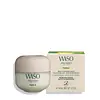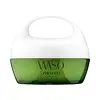What's inside
What's inside
 Key Ingredients
Key Ingredients

 Benefits
Benefits

 Concerns
Concerns

 Ingredients Side-by-side
Ingredients Side-by-side

Water
Skin ConditioningDipropylene Glycol
HumectantAlcohol Denat.
AntimicrobialGlycerin
HumectantPentaerythrityl Tetraethylhexanoate
EmollientMaltitol
HumectantDimethicone
EmollientTrehalose
HumectantEuphorbia Cerifera Wax
Phenoxyethanol
PreservativePEG-240/Hdi Copolymer Bis-Decyltetradeceth-20 Ether
StabilisingPyrus Malus Fruit Water
MaskingCarbomer
Emulsion StabilisingPotassium Hydroxide
BufferingPEG/PPG-17/4 Dimethyl Ether
Skin ConditioningLauroyl Lysine
Skin ConditioningButylene Glycol
HumectantSodium Metaphosphate
BufferingAscorbyl Tetraisopalmitate
AntioxidantSodium Metabisulfite
AntioxidantDisodium EDTA
Dextrin Palmitate
EmulsifyingAcrylates/C10-30 Alkyl Acrylate Crosspolymer
Emulsion StabilisingPhytosteryl/Octyldodecyl Lauroyl Glutamate
Skin ConditioningRosmarinus Officinalis Leaf Oil
MaskingCI 77492
Cosmetic ColorantLimonene
PerfumingCitrus Aurantium Dulcis Oil
MaskingLavandula Angustifolia Oil
MaskingTriisostearin
Skin ConditioningCitrus Junos Seed Extract
AntioxidantTrimethylolpropane Triethylhexanoate
EmollientCitrus Depressa Peel Extract
HumectantCitrus Junos Fruit Extract
Skin ConditioningSalvia Officinalis Oil
MaskingMethicone
EmollientBHT
AntioxidantTetradecene
EmollientTocopherol
AntioxidantWater, Dipropylene Glycol, Alcohol Denat., Glycerin, Pentaerythrityl Tetraethylhexanoate, Maltitol, Dimethicone, Trehalose, Euphorbia Cerifera Wax, Phenoxyethanol, PEG-240/Hdi Copolymer Bis-Decyltetradeceth-20 Ether, Pyrus Malus Fruit Water, Carbomer, Potassium Hydroxide, PEG/PPG-17/4 Dimethyl Ether, Lauroyl Lysine, Butylene Glycol, Sodium Metaphosphate, Ascorbyl Tetraisopalmitate, Sodium Metabisulfite, Disodium EDTA, Dextrin Palmitate, Acrylates/C10-30 Alkyl Acrylate Crosspolymer, Phytosteryl/Octyldodecyl Lauroyl Glutamate, Rosmarinus Officinalis Leaf Oil, CI 77492, Limonene, Citrus Aurantium Dulcis Oil, Lavandula Angustifolia Oil, Triisostearin, Citrus Junos Seed Extract, Trimethylolpropane Triethylhexanoate, Citrus Depressa Peel Extract, Citrus Junos Fruit Extract, Salvia Officinalis Oil, Methicone, BHT, Tetradecene, Tocopherol
Water
Skin ConditioningDipropylene Glycol
HumectantGlycerin
HumectantAlcohol
AntimicrobialPentaerythrityl Tetraethylhexanoate
EmollientMaltitol
HumectantDimethicone
EmollientTrehalose
HumectantEuphorbia Cerifera Wax
Phenoxyethanol
PreservativePEG-240/Hdi Copolymer Bis-Decyltetradeceth-20 Ether
StabilisingCarbomer
Emulsion StabilisingParfum
MaskingPotassium Hydroxide
BufferingSaccharide Isomerate
HumectantTalc
AbrasiveDipotassium Glycyrrhizate
HumectantDextrin Palmitate
EmulsifyingSodium Metaphosphate
BufferingButylene Glycol
HumectantDisodium EDTA
Acrylates/C10-30 Alkyl Acrylate Crosspolymer
Emulsion StabilisingCarthamus Tinctorius Seed Oil
MaskingSerine
MaskingButylphenyl Methylpropional
PerfumingLimonene
PerfumingHexyl Cinnamal
PerfumingLinalool
PerfumingBenzyl Benzoate
AntimicrobialCalcium Stearate
Cosmetic ColorantCI 77492
Cosmetic ColorantCitric Acid
BufferingSodium Citrate
BufferingCitronellol
PerfumingPaeonia Suffruticosa Root Extract
Skin ProtectingGeraniol
PerfumingDaucus Carota Sativa Root Protoplasts
EmollientCitrus Junos Seed Extract
AntioxidantPEG-30 Phytosterol
EmulsifyingHydrogenated Lecithin
EmulsifyingTriisostearin
Skin ConditioningPanax Ginseng Root Extract
EmollientBHT
AntioxidantTrimethylolpropane Triethylhexanoate
EmollientPlankton Extract
Skin ConditioningSodium Phosphate
BufferingTrisodium EDTA
Polysilicone-2
Tocopherol
AntioxidantWater, Dipropylene Glycol, Glycerin, Alcohol, Pentaerythrityl Tetraethylhexanoate, Maltitol, Dimethicone, Trehalose, Euphorbia Cerifera Wax, Phenoxyethanol, PEG-240/Hdi Copolymer Bis-Decyltetradeceth-20 Ether, Carbomer, Parfum, Potassium Hydroxide, Saccharide Isomerate, Talc, Dipotassium Glycyrrhizate, Dextrin Palmitate, Sodium Metaphosphate, Butylene Glycol, Disodium EDTA, Acrylates/C10-30 Alkyl Acrylate Crosspolymer, Carthamus Tinctorius Seed Oil, Serine, Butylphenyl Methylpropional, Limonene, Hexyl Cinnamal, Linalool, Benzyl Benzoate, Calcium Stearate, CI 77492, Citric Acid, Sodium Citrate, Citronellol, Paeonia Suffruticosa Root Extract, Geraniol, Daucus Carota Sativa Root Protoplasts, Citrus Junos Seed Extract, PEG-30 Phytosterol, Hydrogenated Lecithin, Triisostearin, Panax Ginseng Root Extract, BHT, Trimethylolpropane Triethylhexanoate, Plankton Extract, Sodium Phosphate, Trisodium EDTA, Polysilicone-2, Tocopherol
Ingredients Explained
These ingredients are found in both products.
Ingredients higher up in an ingredient list are typically present in a larger amount.
Acrylates/C10-30 Alkyl Acrylate Crosspolymer is a synthetic polymer. It is used to thicken and improve the texture of products. Due to its properties, it can prevent water and oil ingredients from separating.
BHT is a synthetic antioxidant and preservative.
As an antioxidant, it helps your body fight off free-radicals. Free-radicals are molecules that may damage your skin cells.
As a preservative, it is used to stabilize products and prevent them from degrading. Specifically, BHT prevents degradation from oxidation.
The concerns related to BHT come from oral studies; this ingredient is currently allowed for use by both the FDA and EU.
However, it was recently restricted for use in the UK as of April 2024.
Learn more about BHTButylene Glycol (or BG) is used within cosmetic products for a few different reasons:
Overall, Butylene Glycol is a safe and well-rounded ingredient that works well with other ingredients.
Though this ingredient works well with most skin types, some people with sensitive skin may experience a reaction such as allergic rashes, closed comedones, or itchiness.
Learn more about Butylene GlycolCarbomer is a polymer of acrylic acid. Its main role is to create a gel consistency.
A high amount of carbomer can cause pilling or balling up of products. Don't worry, most products contain 1% or less of carbomer.
Ci 77492 is also hydrated iron III oxide. It's sole purpose is to give a yellow hue to products.
Iron III oxides are classified as inorganic chemicals for coloring.
Synthetically created Ci 77492 is considered safer than those naturally found. This is because the synthetically created version may contain less impurities. Iron oxides are generally non-toxic and non-allergenic.
Learn more about CI 77492Citrus Junos Seed Extract comes from the Yuzu fruit.
Yuzu fruit seeds have been found to be anti-inflammatory.
Yuzu has many skin benefits. It contains antioxidants and a variety of Vitamins. The vitamins found in yuzu include: Vitamin C, Vitamin A, Vitamin B6, and Vitamin B5.
Learn more about Citrus Junos Seed ExtractDextrin Palmitate comes from the palmitic acid ester of Dextrin. It is used as an emulsifier and texture enhancer.
Emulsifiers help keep ingredients together. According to a manufacturer, dextrin palmitate helps create a low-viscosity gel texture.
Due to its fatty acid base, this ingredient is not fungal-acne safe.
Learn more about Dextrin PalmitateDimethicone is a type of synthetic silicone created from natural materials such as quartz.
What it does:
Dimethicone comes in different viscosities:
Depending on the viscosity, dimethicone has different properties.
Ingredients lists don't always show which type is used, so we recommend reaching out to the brand if you have questions about the viscosity.
This ingredient is unlikely to cause irritation because it does not get absorbed into skin. However, people with silicone allergies should be careful about using this ingredient.
Note: Dimethicone may contribute to pilling. This is because it is not oil or water soluble, so pilling may occur when layered with products. When mixed with heavy oils in a formula, the outcome is also quite greasy.
Learn more about DimethiconeDipropylene Glycol is a synthetically created humectant, stabilizer, and solvent.
This ingredient helps:
Dipropylene glycol is technically an alcohol, but it belongs to the glycol family (often considered part of the ‘good’ alcohols). This means it is hydrating and gentle on skin unlike drying solvent alcohols like denatured alcohol.
As a masking agent, Dipropylene Glycol can be used to cover the smell of other ingredients. However, it does not have a scent.
Studies show Dipropylene Glycol is considered safe to use in skincare.
Learn more about Dipropylene GlycolDisodium EDTA plays a role in making products more stable by aiding other preservatives.
It is a chelating agent, meaning it neutralizes metal ions that may be found in a product.
Disodium EDTA is a salt of edetic acid and is found to be safe in cosmetic ingredients.
Learn more about Disodium EDTAGlycerin is already naturally found in your skin. It helps moisturize and protect your skin.
A study from 2016 found glycerin to be more effective as a humectant than AHAs and hyaluronic acid.
As a humectant, it helps the skin stay hydrated by pulling moisture to your skin. The low molecular weight of glycerin allows it to pull moisture into the deeper layers of your skin.
Hydrated skin improves your skin barrier; Your skin barrier helps protect against irritants and bacteria.
Glycerin has also been found to have antimicrobial and antiviral properties. Due to these properties, glycerin is often used in wound and burn treatments.
In cosmetics, glycerin is usually derived from plants such as soybean or palm. However, it can also be sourced from animals, such as tallow or animal fat.
This ingredient is organic, colorless, odorless, and non-toxic.
Glycerin is the name for this ingredient in American English. British English uses Glycerol/Glycerine.
Learn more about GlycerinLimonene is a fragrance that adds scent and taste to a formulation.
It's found in the peel oil of citrus fruits and other plants such as lavender and eucalyptus. The scent of limonene is generally described as "sweet citrus".
Limonene acts as an antioxidant, meaning it helps neutralize free radicals.
When exposed to air, oxidized limonene may sensitize the skin. Because of this, limonene is often avoided by people with sensitive skin.
The term 'fragrance' is not regulated in many countries. In many cases, it is up to the brand to define this term. For instance, many brands choose to label themselves as "fragrance-free" because they are not using synthetic fragrances. However, their products may still contain ingredients such as essential oils that are considered a fragrance.
Learn more about LimoneneWe don't have a description for Maltitol yet.
We don't have a description for PEG-240/Hdi Copolymer Bis-Decyltetradeceth-20 Ether yet.
Pentaerythrityl Tetraethylhexanoate is an emollient that helps make your skin smooth and hydrated. It specializes in creating a non-oily and "wet" feeling on skin.
This ingredient comes from isostearic acid, a saturated fatty acid. It is a synthetic ingredient.
Phenoxyethanol is a preservative that has germicide, antimicrobial, and aromatic properties. Studies show that phenoxyethanol can prevent microbial growth. By itself, it has a scent that is similar to that of a rose.
It's often used in formulations along with Caprylyl Glycol to preserve the shelf life of products.
Potassium hydroxide is commonly known as caustic potash. It is used to fix the pH of a product or as a cleaning agent in soap. In cleansers, it is used for the saponification of oils.
Sapnification is the process of creating fatty acid metal salts from triglycerides and a strong base. During this process, Potassium Hydroxide is used up and is not present in the final product.
Using high concentrations of Potassium Hydroxide have shown to irritate the skin.
Learn more about Potassium HydroxideWe don't have a description for Sodium Metaphosphate yet.
Tocopherol (also known as Vitamin E) is a common antioxidant used to help protect the skin from free-radicals and strengthen the skin barrier. It's also fat soluble - this means our skin is great at absorbing it.
Vitamin E also helps keep your natural skin lipids healthy. Your lipid skin barrier naturally consists of lipids, ceramides, and fatty acids. Vitamin E offers extra protection for your skin’s lipid barrier, keeping your skin healthy and nourished.
Another benefit is a bit of UV protection. Vitamin E helps reduce the damage caused by UVB rays. (It should not replace your sunscreen). Combining it with Vitamin C can decrease sunburned cells and hyperpigmentation after UV exposure.
You might have noticed Vitamin E + C often paired together. This is because it is great at stabilizing Vitamin C. Using the two together helps increase the effectiveness of both ingredients.
There are often claims that Vitamin E can reduce/prevent scarring, but these claims haven't been confirmed by scientific research.
Learn more about TocopherolTrehalose is a disaccharide made of two glucose molecules (glucose is sugar!). Trehalose is used to help moisturize skin. It also has antioxidant properties.
As a humectant, trehalose helps draw moisture from the air to your skin. This helps keep your skin hydrated.
Due to its antioxidant properties, trehalose may help with signs of aging. Antioxidants help fight free-radical molecules, unstable molecules that may damage your skin.
In medicine, trehalose and hyaluronic acid are used to help treat dry eyes.
Some animals, plants, and bacteria create trehalose as a source of energy to survive freeze or lack of water.
Learn more about TrehaloseTriisostearin isn't fungal acne safe.
We don't have a description for Trimethylolpropane Triethylhexanoate yet.
Water. It's the most common cosmetic ingredient of all. You'll usually see it at the top of ingredient lists, meaning that it makes up the largest part of the product.
So why is it so popular? Water most often acts as a solvent - this means that it helps dissolve other ingredients into the formulation.
You'll also recognize water as that liquid we all need to stay alive. If you see this, drink a glass of water. Stay hydrated!
Learn more about WaterEuphorbia Cerifera wax comes from a shrub in Northern Mexico. It is used to stabilize formulations and has emollient properties.
Emollients form a thin layer on top of skin to prevent water from evaporating, keeping skin and lips hydrated.
According to a manufacturer, this wax can range from a yellow/brown color to translucent.
Learn more about Euphorbia Cerifera Wax